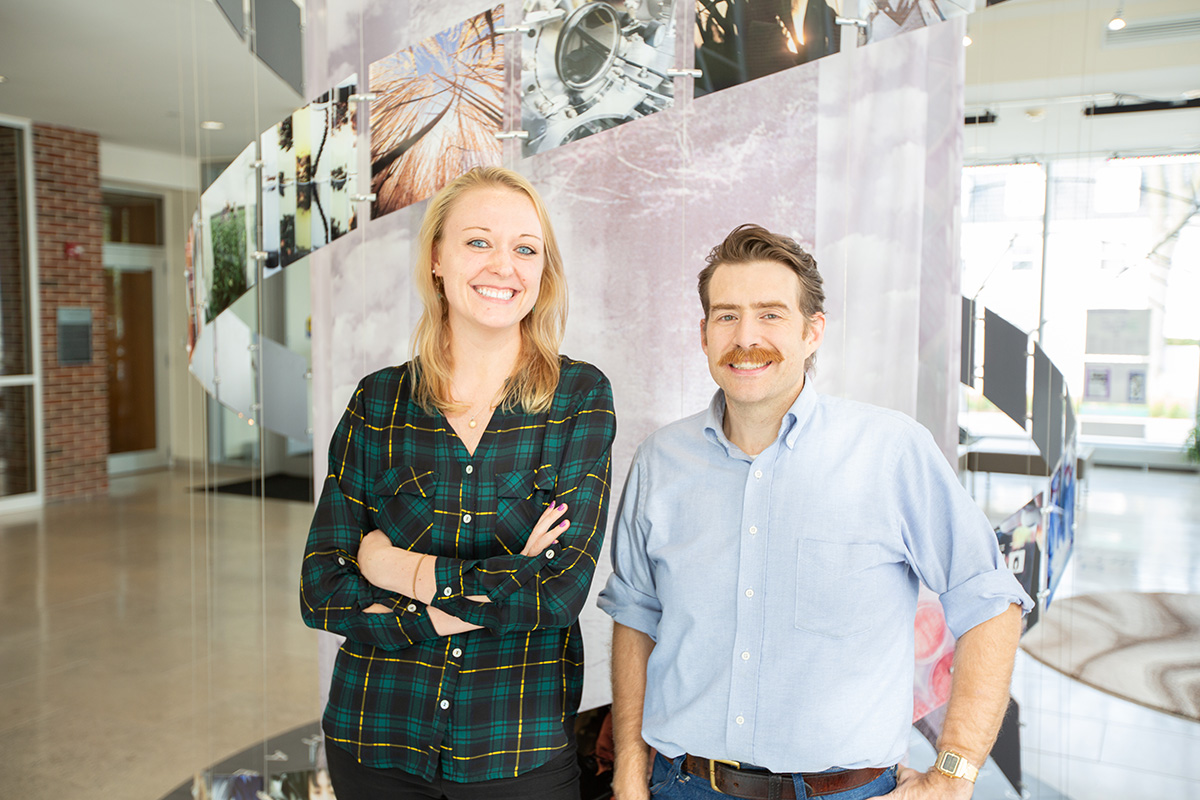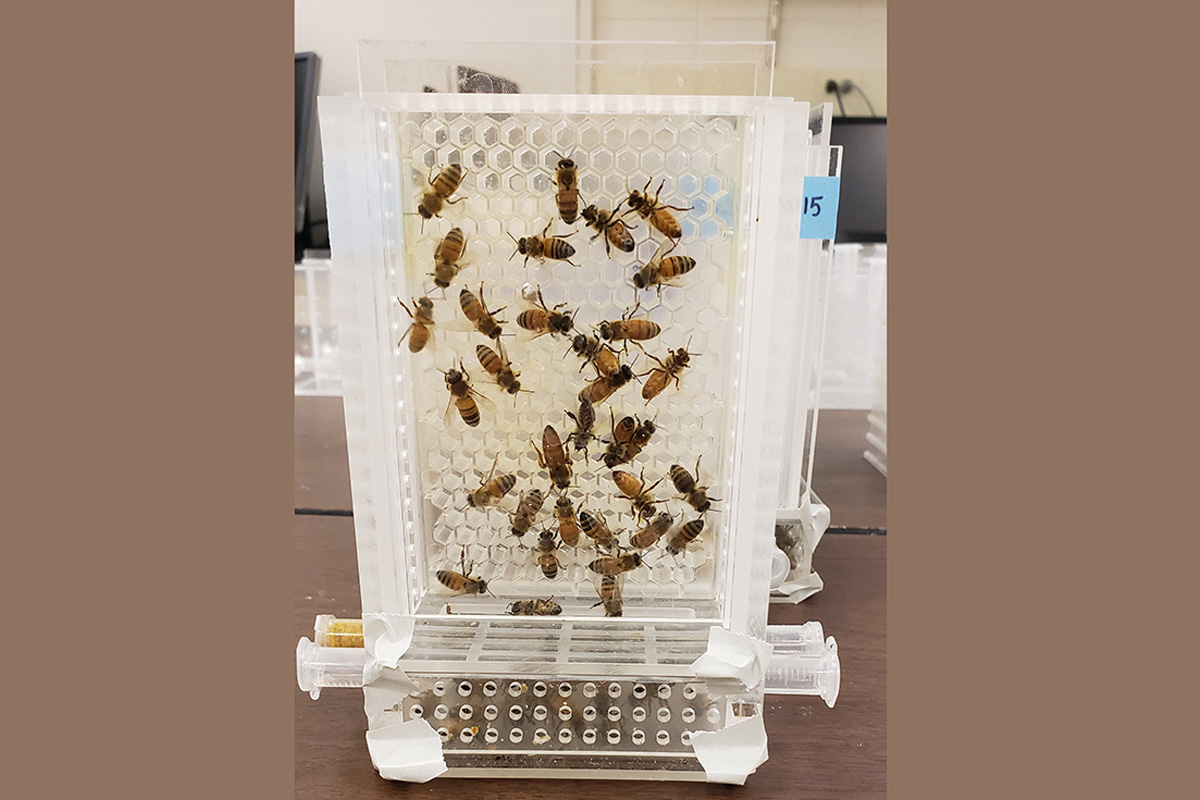Honey bees prosper with quality, not quantity, of food in novel laboratory setup
Honey bee workers collect pollen and nectar from a variety of flowering plants to use as a food source. Honey bees typically forage from up to 1-2 miles away from the hive, though sometimes they travel even further, including up to 10 miles away. However, much of the modern landscape consists of agricultural fields, which limits the foraging options for honey bees in these areas. Furthermore, when crops decline at summer’s end, honey bee populations in corn-soy heavy areas experience massive losses, posing the question of how agricultural landscapes impact the type of food the honey bees bring in, and if this food then affects the queen’s production of eggs. Adam Dolezal (IGOH), an assistant professor of entomology at University of Illinois Urbana-Champaign, and Ashley St. Clair, a postdoctoral researcher in Dolezal’s lab, explored these questions in a new paper published in Frontiers in Sustainable Food Systems.

Their study involved two components. The first involved placing honey bee colonies across differing agricultural vs wildflower prairie landscapes, and measuring the species and amount of pollen collected, as well as the number of eggs laid by the queen. The researchers found that the quantity of pollen didn’t vary based on crop vs prairie location, but that the species of pollen did, the main difference being that honey bees near prairie collected more evening primrose pollen than honey bees near crop fields. Additionally, queens from colonies placed closer to prairie laid more eggs than those near crop fields, particularly in late summer, when crop availability decreases. St. Clair explained that this result did vary a bit year by year, because field experiments with honey bees have so many variables to account for.
“It's very complicated in the field to tease apart these differences. I mean, it could be corn, pesticides, the randomness in the colonies…It could be all kinds of interactions,” said St. Clair. “We wanted to see if we could replicate those findings in the lab because it would mean that pollen nutrition was actually an indicator of that reduced queen egg laying we see in August, and not some other environmental factor.”
For the second part of the study, the researchers used small microcolony honey bee boxes to test the question of nutritional impacts on egg laying in a controlled laboratory setting, the first study replicate a field experiment in this way. The cage is made of two clear pieces that snap together around an injection-molded 264-well honeycomb plate for the bees to store food and for the queen to lay eggs in. At the bottom, there's a trough that food can be put into for worker bees to collect, but that the queen can’t access.

The cages were originally designed by IGB Director Gene Robinson’s (GNDP) lab, to be used for automated beekeeping. However, St. Clair and Dolezal discovered they were an excellent way to house multiple colonies together in a laboratory setting, with each colony holding about 60-100 honey bees. The colonies were fed one of three treatment diets that mimicked the dietary mixtures found in the field component of the study: crop mixture, prairie mixture, or 100% evening primrose, which was added to see if its nutritional value was the reason the honey bees favored it as a pollen source in the field. The researchers then counted the number of eggs the queen of each colony had laid every day.
In line with what was found in the field, queens laid more eggs under the prairie diet compared to those under the crop or primrose diet. The results from both the field and lab components of the study suggest that honey bee colonies do better when given a diverse diet, as would be found in a field of prairie flowers, compared to a less diverse diet of crops.
“The results indicate that it's the quality of the pollen that matters more than the quantity that they're bringing in,” St. Clair said. “There are specific pollens, like evening primrose, that when mixed in can be more nutritious overall. However, in the lab, primrose did not provide enough nutrition by itself to change the queen's fecundity. So, the take home here is that the honey bees need a diverse diet.”
So, what can farmers and/or beekeepers do to help honey bees through the shortage of food in August? The researchers explained that prairie strips, which are already being implemented by farmers for other reasons, come with the added benefit of helping the honey bees. By placing strips of native prairie plants around water ways and farm edges, farmers reduce erosion and water loss on their farms, and also provide an additional food source for honey bees. And with laboratory studies like this, researchers can give better suggestions on what types of prairie plants to provide on the strips.
“This is a new way of thinking about what we're measuring in these colonies,” said Dolezal. “Being able to see that when you have this or that on your landscape, your queens are more productive, is really valuable.”
The team plans to use the microcolony cage system for the next research steps, which will focus on pesticide exposure and interactions with pollen on queen fecundity. Pesticides present a large problem for bees in general, but the specific effects of pesticides can be hard to study in such variable field settings. Dolezal explained that this laboratory microcolony system provides an excellent controlled setting to continue exploring these questions in the future.
“There's a lot you can do with this system, and coming from someone who has been doing work in the field, this is like magic,” Dolezal said. “This laboratory system will allow us to conduct manipulative experiments and look very finely at what's going on in the honey bee colonies.”
This work, titled “Access to prairie pollen affects honey bee queen fecundity in the field and lab”, was supported by the USDA and the Eastern Apicultural Society. https://doi.org/10.3389/fsufs.2022.908667
